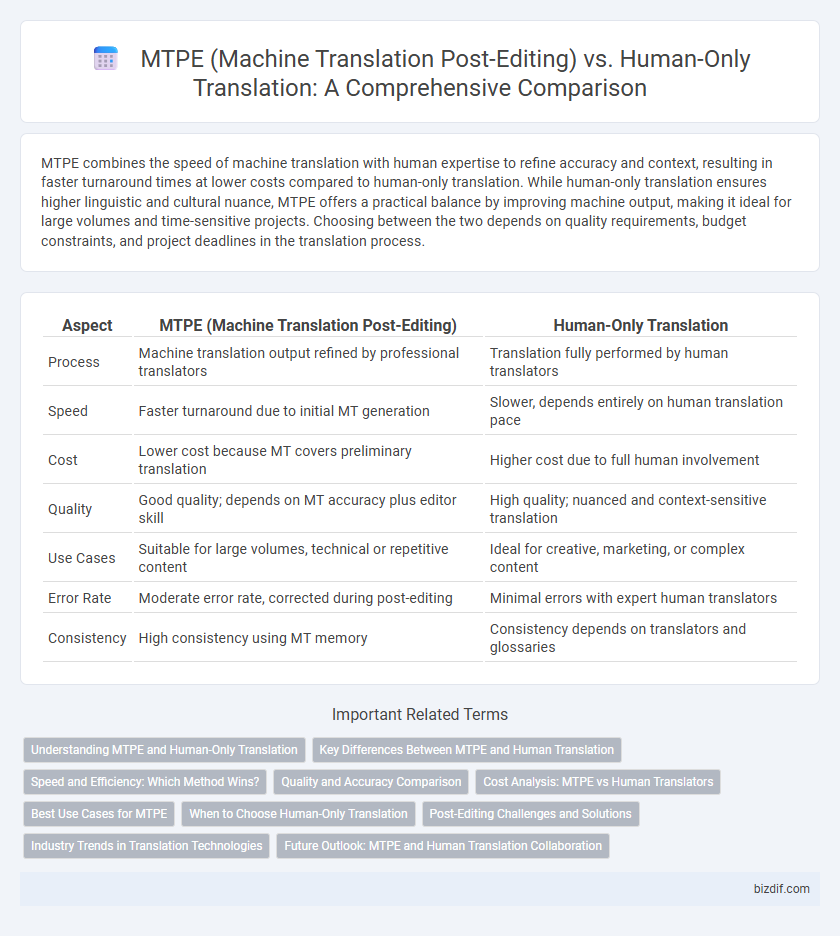MTPE combines the speed of machine translation with human expertise to refine accuracy and context, resulting in faster turnaround times at lower costs compared to human-only translation. While human-only translation ensures higher linguistic and cultural nuance, MTPE offers a practical balance by improving machine output, making it ideal for large volumes and time-sensitive projects. Choosing between the two depends on quality requirements, budget constraints, and project deadlines in the translation process.
Table of Comparison
| Aspect | MTPE (Machine Translation Post-Editing) | Human-Only Translation |
|---|---|---|
| Process | Machine translation output refined by professional translators | Translation fully performed by human translators |
| Speed | Faster turnaround due to initial MT generation | Slower, depends entirely on human translation pace |
| Cost | Lower cost because MT covers preliminary translation | Higher cost due to full human involvement |
| Quality | Good quality; depends on MT accuracy plus editor skill | High quality; nuanced and context-sensitive translation |
| Use Cases | Suitable for large volumes, technical or repetitive content | Ideal for creative, marketing, or complex content |
| Error Rate | Moderate error rate, corrected during post-editing | Minimal errors with expert human translators |
| Consistency | High consistency using MT memory | Consistency depends on translators and glossaries |
Understanding MTPE and Human-Only Translation
MTPE (Machine Translation Post-Editing) involves refining automated translations to enhance accuracy and coherence, significantly reducing turnaround times compared to Human-Only Translation. Human-Only Translation relies solely on linguistic expertise to produce culturally sensitive and contextually accurate content without machine assistance. Understanding the balance between MTPE and Human-Only Translation is essential for optimizing quality, efficiency, and cost in multilingual communication.
Key Differences Between MTPE and Human Translation
MTPE combines machine translation speed with human expertise to correct errors and improve fluency, significantly reducing turnaround times compared to human-only translation. Human translation relies entirely on linguistic intuition and cultural knowledge for nuanced, context-aware outputs but demands more time and cost. MTPE often sacrifices some stylistic finesse for efficiency, whereas human translation excels in accuracy, creativity, and adaptability to complex texts.
Speed and Efficiency: Which Method Wins?
MTPE significantly outperforms human-only translation in speed and efficiency by leveraging machine-generated content that requires only targeted human corrections, cutting project turnaround times by up to 50%. Human-only translation, while offering nuanced language and contextual accuracy, demands considerably longer hours and higher resource investment. For large-scale projects prioritizing rapid delivery without compromising basic quality, MTPE remains the optimal choice for maximizing productivity.
Quality and Accuracy Comparison
MTPE leverages machine-generated drafts to accelerate the translation process while maintaining high quality through human post-editing, resulting in faster turnaround compared to human-only translation. Human-only translation often delivers superior accuracy and nuanced language use, particularly in complex or culturally sensitive texts. Studies indicate MTPE achieves up to 85-95% accuracy in standard content but may require extensive edits to match the precision of expert human translation in specialized fields.
Cost Analysis: MTPE vs Human Translators
Machine Translation Post-Editing (MTPE) significantly reduces translation costs by combining automated initial drafts with human revisions, cutting expenses by up to 40% compared to human-only translation. Human-only translation demands higher labor costs, skilled linguists, and longer turnaround times, driving up overall project budgets. MTPE balances quality and efficiency, offering cost-effective scalability for large volumes without compromising essential editorial oversight.
Best Use Cases for MTPE
MTPE excels in projects requiring quick turnarounds and large volume translation where maintaining a balance between speed and quality is crucial. It is ideal for content with repetitive terminology or less creative material such as technical manuals, product descriptions, and user guides. Human-only translation remains preferable for nuanced, culturally sensitive, and highly creative content like literary works, marketing campaigns, and legal documents.
When to Choose Human-Only Translation
Human-Only Translation is preferred when accuracy, cultural nuance, and specialized terminology are critical, such as in legal, medical, or literary content. Complex texts requiring deep contextual understanding benefit from human translators' expertise, reducing risks of misinterpretation or errors common in machine-generated drafts. Projects with a high emphasis on brand voice and emotional tone also demand human-only translation to maintain authenticity and engagement.
Post-Editing Challenges and Solutions
Machine Translation Post-Editing (MTPE) faces challenges such as handling idiomatic expressions, maintaining context accuracy, and correcting machine-generated errors, which often require specialized linguistic expertise. Effective solutions include implementing adaptive machine learning models, providing comprehensive post-editor training, and using collaborative workflows that combine human intuition with AI precision. These strategies help improve translation quality and efficiency, bridging the gap between raw MT output and fully refined human-only translations.
Industry Trends in Translation Technologies
Machine Translation Post-Editing (MTPE) combines AI-driven translation engines with expert human refinement to enhance accuracy and efficiency, reducing turnaround times in global localization projects. Industry trends show growing adoption of MTPE in sectors like e-commerce, gaming, and legal services due to its cost-effectiveness and scalability compared to traditional human-only translation. Advances in neural machine translation and AI-powered quality assurance are driving higher acceptance of MTPE workflows, reshaping translation technology landscapes worldwide.
Future Outlook: MTPE and Human Translation Collaboration
The future of translation lies in the seamless collaboration between Machine Translation Post-Editing (MTPE) and human translation, leveraging artificial intelligence to increase efficiency without sacrificing linguistic accuracy. Advanced neural machine translation models continuously improve, enabling human editors to focus on localization, cultural nuances, and stylistic refinement. This hybrid approach optimizes cost, speed, and quality, positioning MTPE as an essential complement to professional human translation in global content workflows.
MTPE (Machine Translation Post-Editing) vs Human-Only Translation Infographic

 bizdif.com
bizdif.com